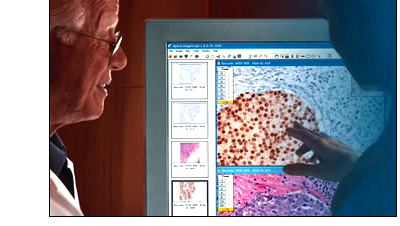| |
Techniques for Image Analysis to Automated Diagnosis
 The advent of digital pathology is still far from replacing trained pathologists. However, in order to continue the trend from
image analysis to automated diagnosis it is essential to have standardization procedures in acquiring information from a digitized slide.
Engineers must create algorithms that assess images with diagnostic value as a pathologist would. For artificial intelligent
imaging systems, the important parameters are discussed below:
The advent of digital pathology is still far from replacing trained pathologists. However, in order to continue the trend from
image analysis to automated diagnosis it is essential to have standardization procedures in acquiring information from a digitized slide.
Engineers must create algorithms that assess images with diagnostic value as a pathologist would. For artificial intelligent
imaging systems, the important parameters are discussed below:
- Image Standardization-a number of factors contribute to glass slide variations including but not limited to
thickness of the cuts and staining intensity. These factors must be corrected during the information extraction
phase from the virtual slide.
- Selection of Segmentation Thresholds-images must be pre-analyzed to select useful object segmentation.
- Segmentation Algorithms-object and structure information require accurate magnification which can be achieved
with appropriate segmentation algorithms. Algorithms involve choosing a simple gray value to determine the object space
and the application of a number of algorithms to identify object boundaries.
- Sampling Algorithms of Field of View-fields of view that are diagnostically significant must be chosen with
well structured sampling methods which may include self-adjusting segmentation procedures or implementations in distributed
manners.
- Texture Analysis-information such as translation figures, image entropy, and symmetries can be extracted
from pixel-based images using texture analysis algorithms. Here texture is a pixel based gray value that is independent
of external setups. It involves image transformations such as Fourier, Hough, and Hadamard methods. Texture analyses
have been used in classifying lung cancer cell types and cancer cell types of various origins.
- Structure Analysis-the spatial position of objects is necessary to extract feature measurements. This requires
a mathematical procedure and a neighborhood condition where graph theory is often applied for analyses. Structure analysis
is related to symmetry operations in pathology to contrast between normal glandular organs and cancer.
- Statistical Analysis-analysis of quantified parameters and classification schemes must be performed
to generate automated diagnosis.
- Continuous Improvement of Classification Procedures-results should be monitored and re-evaluated, in which
classification procedures are readjusted if necessary.
Follow the links below to visualize example quality corrections, algorithms, and results of the parameters discussed above.
|
|
